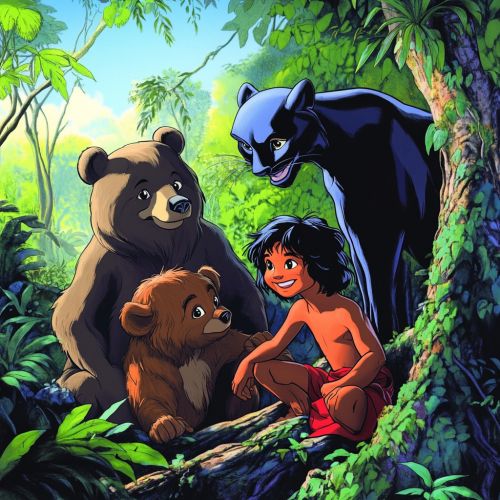The Jungle Book
Introduction
The Jungle Book is a collection of stories by the English author Rudyard Kipling. Most of the characters are animals such as Shere Khan the tiger and Baloo the bear, though a principal character is the boy or "man-cub" Mowgli, who is raised in the jungle by wolves. The stories are set in a forest in India; one place mentioned repeatedly is "Seonee" (Seoni), in the central state of Madhya Pradesh.
Background and Publication
The Jungle Book was first published in 1894, and it has since become one of Kipling's most enduring works. The stories were originally published in magazines in 1893–94. The original publications contained illustrations, some by Kipling's father, John Lockwood Kipling. The tales in the book are fables, using animals in an anthropomorphic manner to give moral lessons. The verses of The Law of the Jungle, for example, lay down rules for the safety and well-being of individuals, families, and communities.
Structure and Content
The Jungle Book is divided into seven stories, each with its own unique narrative and moral lesson. The most famous of these stories is "Mowgli's Brothers," which introduces the character of Mowgli and his wolf family. Other notable stories include "Kaa's Hunting," "Tiger! Tiger!," and "The White Seal."
Mowgli's Brothers
In "Mowgli's Brothers," a human child named Mowgli is found by a pack of wolves in the jungle. The wolves raise him as one of their own, and he learns the ways of the jungle from Baloo the bear and Bagheera the black panther. The story explores themes of identity, belonging, and the conflict between civilization and nature.
Kaa's Hunting
"Kaa's Hunting" follows Mowgli as he is kidnapped by the Bandar-log (monkeys) and rescued by Kaa the python. This story emphasizes the importance of trust and loyalty, as well as the dangers of arrogance and disobedience.
Tiger! Tiger!
In "Tiger! Tiger!," Mowgli returns to the human village and struggles to adapt to human society. He eventually kills Shere Khan, the tiger who has been his enemy since childhood. This story deals with themes of revenge, justice, and the clash between human and animal worlds.
The White Seal
"The White Seal" tells the story of Kotick, a rare white-furred seal who seeks a safe haven for his fellow seals. The story highlights themes of perseverance, leadership, and the search for a utopia.
Rikki-Tikki-Tavi
"Rikki-Tikki-Tavi" is the tale of a brave mongoose who protects a human family from a pair of deadly cobras. This story is often praised for its thrilling narrative and vivid depiction of animal behavior.
Toomai of the Elephants
"Toomai of the Elephants" follows a young boy named Toomai who dreams of becoming a great elephant handler. The story explores themes of ambition, tradition, and the bond between humans and animals.
Her Majesty's Servants
"Her Majesty's Servants" is a story about the animals in a British military camp in India. The story provides a unique perspective on colonialism and the role of animals in human conflicts.
Themes and Analysis
The Jungle Book explores a wide range of themes, including the struggle for survival, the importance of community, and the relationship between humans and nature. The stories often reflect Kipling's views on colonialism and the British Empire, as well as his fascination with Indian culture and wildlife.
Survival and Adaptation
Survival is a central theme in The Jungle Book. The characters must constantly adapt to their environment and learn the laws of the jungle to survive. This theme is particularly evident in Mowgli's journey, as he learns to navigate both the animal and human worlds.
Community and Belonging
The importance of community and belonging is another key theme. Mowgli's relationship with his wolf family and his friendships with Baloo and Bagheera highlight the significance of social bonds and mutual support. The stories also emphasize the idea that true belonging comes from understanding and accepting one's identity.
Human-Animal Relationships
The Jungle Book delves into the complex relationship between humans and animals. The stories often portray animals as intelligent and moral beings, capable of teaching humans valuable lessons. This theme is particularly evident in "Rikki-Tikki-Tavi" and "The White Seal," where animals play crucial roles in protecting and guiding humans.
Cultural Impact
The Jungle Book has had a significant cultural impact since its publication. The stories have been adapted into numerous films, television series, and stage productions. The most famous adaptation is Disney's 1967 animated film, which introduced the stories to a new generation of audiences.
Literary Influence
The book has influenced many other works of literature, particularly in the genre of animal fiction. Authors such as Richard Adams, Brian Jacques, and T.H. White have cited The Jungle Book as an inspiration for their own works.
Adaptations
The Jungle Book has been adapted into various forms of media, including films, television series, and stage productions. Notable adaptations include the 1942 live-action film directed by Zoltan Korda, the 1967 Disney animated film, and the 2016 live-action/CGI hybrid film directed by Jon Favreau.
Illustrations and Visual Depictions
The original illustrations for The Jungle Book were created by Rudyard Kipling's father, John Lockwood Kipling. These illustrations have become iconic and are often associated with the stories. Over the years, many artists have created their own interpretations of the characters and scenes from the book.


See Also
References
- Kipling, Rudyard. The Jungle Book. Macmillan & Co., 1894.
- Mallett, Phillip. Rudyard Kipling: A Literary Life. Palgrave Macmillan, 2003.
- Rutherford, Andrew. Kipling's Imperialism: A Study of His Social and Political Attitudes. Oliver & Boyd, 1964.
